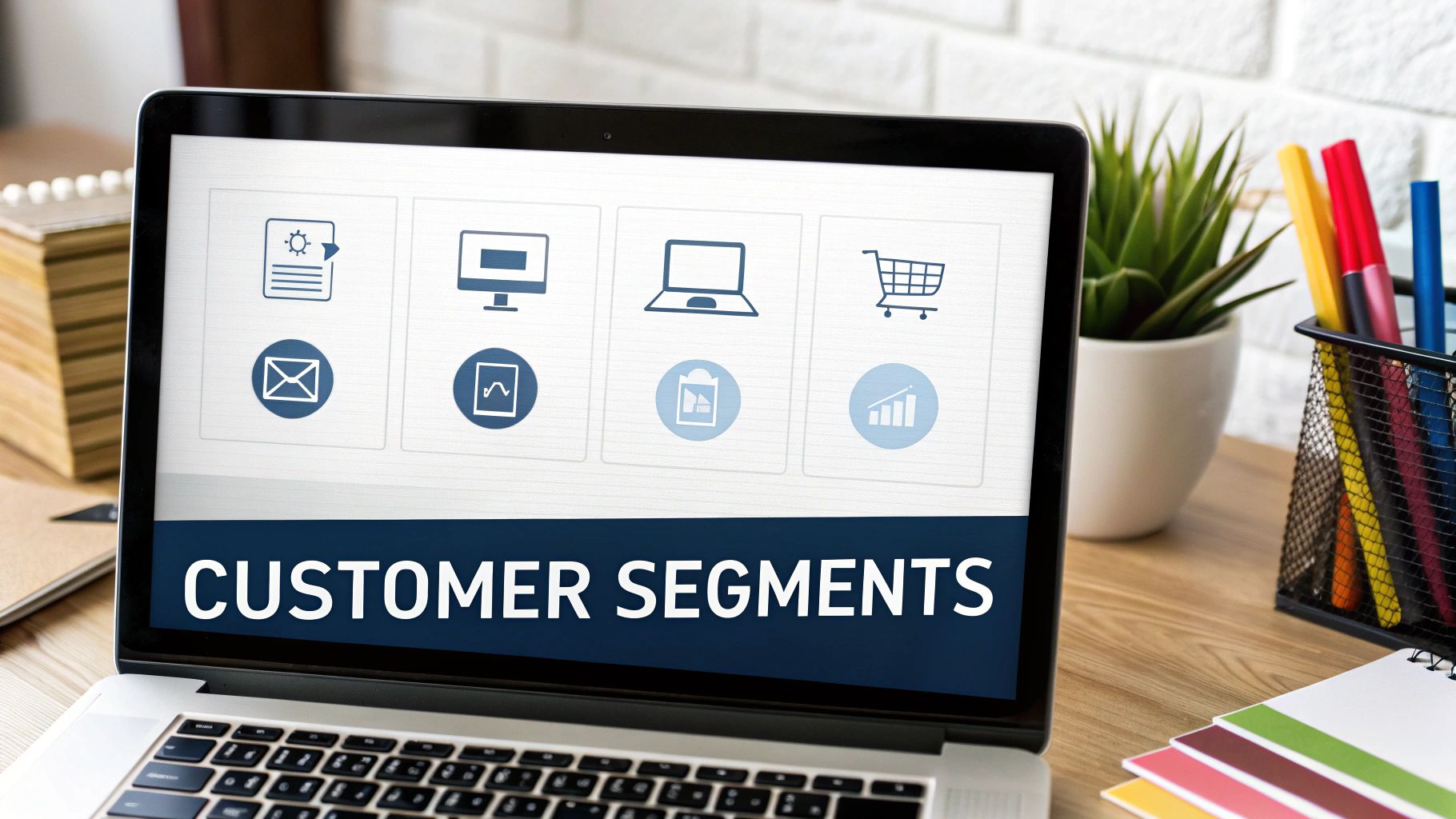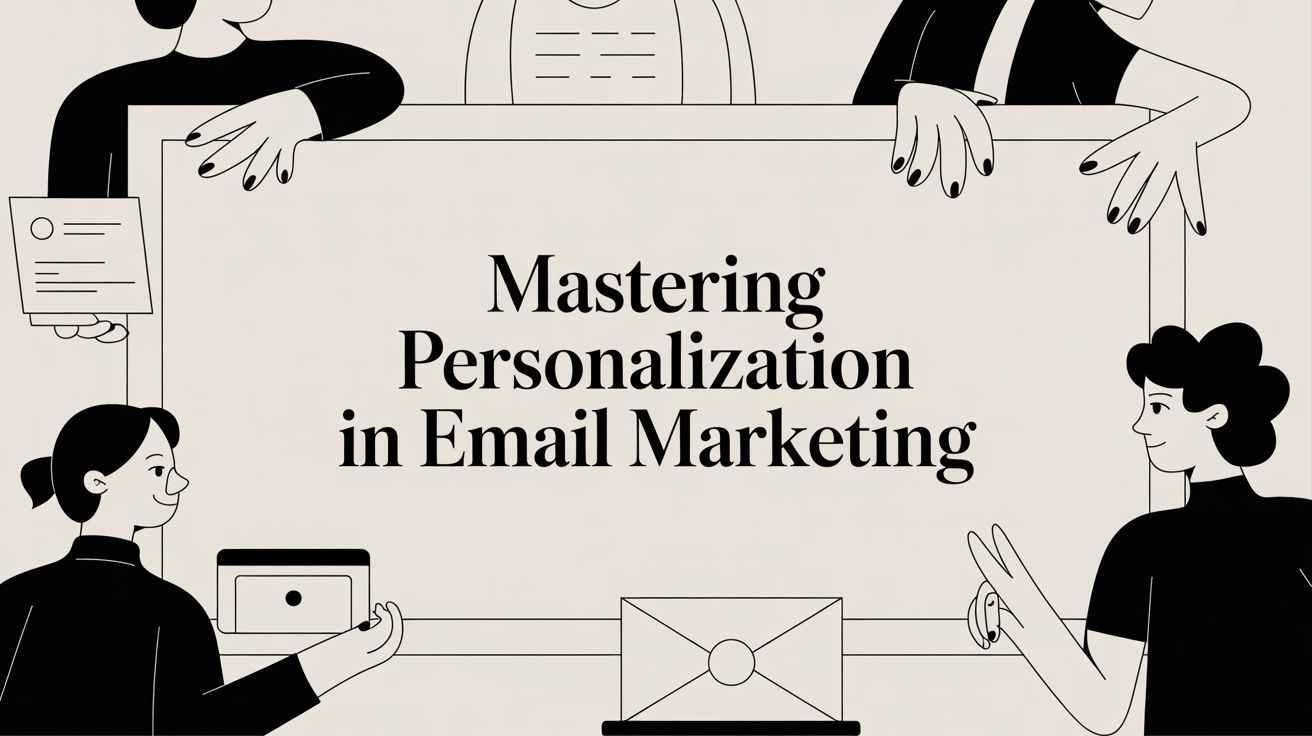Personalization in email marketing is the strategy of using subscriber data to send messages that feel tailor-made for each recipient. It's much more than just dropping a [First Name] into the subject line. True personalization involves tailoring the content, offers, and even the timing of your emails based on an individual's preferences, behaviors, and history with your brand.
The goal? To transform every email from a mass-produced flyer into a relevant, one-to-one conversation. This guide will walk you through, step-by-step, how to make that happen.
The Power of a Personal Connection in the Inbox
Think of traditional email marketing as a brand shouting with a megaphone in a crowded square. The message reaches everyone, but it's generic, loud, and easy to ignore.
Personalization is the opposite. It's like having a helpful conversation with a friend who remembers your interests and past conversations. This shift from broadcasting to conversing is critical because modern customers don't just appreciate a tailored experience—they expect it.
Generic emails are just noise in an overflowing inbox. A personalized message, however, cuts through the clutter because it speaks directly to what that person needs or has shown interest in. It's a clear signal that you see them as an individual, not just another address on a list. This is a core part of how email marketing works to build genuine, lasting relationships.
Why Personalization Is No Longer Optional
In a crowded market, personalization isn't a "nice-to-have"—it's a significant competitive advantage and a direct path to higher engagement and revenue. When an email feels like it was meant for them, people are far more likely to open, click, and convert.
The data backs this up. Studies consistently show that personalized emails can lead to a 29% increase in open rates and a 41% jump in click-through rates. Even more impressively, these tailored messages have been shown to drive six times more transactions.
Actionable Takeaway: The core concept is simple: relevance drives results. When you send the right message to the right person at the right time, you create an experience that builds loyalty and generates revenue.
The Tangible Business Benefits
Adopting a personalization-first mindset delivers measurable wins that directly impact your business growth.
Here are the key benefits you can expect:
- Increased Engagement: Relevant content is valuable content. When you provide genuine value, subscribers open and click more often.
- Stronger Customer Loyalty: People stick with brands that "get" them. Feeling understood is a powerful driver for repeat business.
- Higher Conversion Rates: Showing someone a product they just viewed or an offer related to their past purchases makes the path to purchase much smoother.
- Improved Deliverability: High engagement rates signal to inbox providers like Gmail and Outlook that your emails are wanted, which is the best way to avoid the spam folder.
Ultimately, personalization transforms your email program from a simple broadcast channel into a powerful engine for building relationships. For a deeper look at how this fits into the bigger picture, explore these broader marketing personalization strategies.
Three Actionable Levels of Personalization
Jumping into email personalization can feel overwhelming, but the secret is to start small and build momentum. We can break it down into three clear, progressive levels.
This infographic illustrates the journey from generic, one-size-fits-all messages to truly personal, one-to-one conversations.

As you can see, it's a path from broad announcements to targeted group messages and, finally, to conversations that feel uniquely crafted for each individual. Let's dig into the practical steps for each level.
Levels of Email Personalization at a Glance
| Personalization Level | Common Tactics | Data Required | Expected Impact |
|---|---|---|---|
| Level 1: Basic | Using first names, location-based offers, acknowledging signup source. | Name, email address, basic location (city/state). | Higher open rates, initial boost in engagement. |
| Level 2: Intermediate | Segmenting by demographics, purchase history, and email engagement. | Transaction data, behavioral tracking (clicks, opens), user-provided info (age, job title). | Increased click-through rates, better conversion, lower unsubscribe rates. |
| Level 3: Advanced | Behavioral triggers (abandoned cart), dynamic content, AI-driven product recommendations. | Real-time browsing data, full purchase history, integrated user profiles across platforms. | Significant lift in revenue per email, improved customer loyalty and lifetime value. |
This table shows the progression—each level adds a layer of sophistication, requiring more robust data but delivering a much stronger impact.
Level 1: Basic Personalization
This is your starting line and the foundation for everything that follows. Basic personalization uses simple data points to make emails feel more human. The best part? It's accessible to everyone, regardless of your email platform.
It’s the marketing equivalent of a barista remembering your name—a small touch that makes the experience feel welcoming and less transactional.
Step-by-Step Advice:
- Use First Names: Add a
[FirstName]merge tag to your subject line or greeting. "A special offer for Jessica" is far more compelling than "A special offer for our customers." - Target by Location: If you know a subscriber's city, send a promotion for a local event or store. Simple, yet highly effective.
- Acknowledge Signup Source: Recognize how they joined your list. For example, "Thanks for signing up at our webinar last week!"
This level only needs fundamental data—a name, an email, maybe a city. The payoff is immediate, showing subscribers you're paying attention.
Level 2: Intermediate Personalization
Once you've mastered the basics, it's time to graduate to segmentation—grouping your audience based on shared characteristics or behaviors. Instead of just using a name, you now tailor the entire message to specific, relevant groups.
Think of it like a bookstore organizing its sections. You wouldn't find a cookbook in the sci-fi aisle. You group similar items for people with shared interests.
Step-by-Step Advice:
- Analyze User Data: Look beyond basic info. Track what subscribers click on, what they buy, and how often they open your emails.
- Create Your First Segments: Group subscribers based on:
- Demographics: Age, gender, or job title. A clothing retailer could send different styles to its male and female subscribers.
- Past Purchase History: Target customers who bought running shoes with an email about new high-performance socks.
- Email Engagement: Create a segment of your most active subscribers ("superfans") for exclusive offers, or a segment of inactive users for a re-engagement campaign.
Level 3: Advanced Personalization
Welcome to the big leagues. Advanced personalization, or hyper-personalization, uses real-time data, automation, and AI to create a true one-to-one experience. It’s dynamic, timely, and incredibly powerful.
This is like having a personal shopper who knows your style and what you were browsing on the website five minutes ago—and sends a perfectly timed offer for it.
Industry Insight: This level of detail makes customers feel seen and understood. By anticipating their needs, you shift from being a reactive marketer to a proactive partner in their buying journey.
Step-by-Step Advice:
- Set Up Behavioral Triggers: These are automated emails sent in response to a user action. The most common are welcome series for new subscribers and abandoned cart reminders for shoppers.
- Use Dynamic Content: This is where specific blocks of content within an email change based on who is opening it. An airline's promotional email could show flight deals departing from each subscriber's nearest airport.
- Implement AI-Powered Recommendations: Use artificial intelligence to analyze user behavior and suggest products they are almost guaranteed to love. This is the magic behind the recommendation engines of giants like Amazon and Netflix.
Building High-Impact Customer Segments

Trying to personalize without smart segmentation is like shouting one message into a crowded room and hoping it connects. Segmentation, on the other hand, is like asking people in that room to form smaller groups based on shared interests. Suddenly, you can have relevant conversations with each group.
This process of slicing your email list into focused groups is the engine behind any great personalization strategy.
Moving Beyond Basic Demographics
While starting with age or location is fine, real impact comes from understanding how people behave—what they click on, what they buy, and how they interact with your brand.
To build segments that drive results, you have to dig into the data you’re already collecting. Look at purchase histories, website browsing patterns, and email engagement. These actions tell a much richer story. For a deeper dive, check out a comprehensive guide to building your customer segmentation strategy.
Actionable Segmentation Strategies You Can Use Today
Don't get bogged down by analyzing every data point. Start with a few high-impact segments to get some quick wins and valuable feedback.
Here are three powerful ways to segment your list.
1. Segmentation by Purchase History
This is one of the most powerful strategies for any business. By grouping people based on what they've bought, you can send hyper-relevant offers.
- Real-World Example: A customer buys a new camera.
- First-Time Buyers: Create a dedicated welcome series that shows them how to get the most out of their purchase and offers a small discount on a future order.
- Repeat Customers: These are your fans! Treat them like VIPs with early access to new products or exclusive promotions.
- Specific Product Purchasers: The camera buyer is a prime candidate for emails about compatible lenses, a camera bag, or memory cards.
2. Segmentation by Engagement Level
Not everyone on your list hangs on your every word. Separating subscribers by how they interact with your emails allows you to nurture your biggest fans while trying to win back those who have drifted.
Just starting to build your list? You'll want to check out our guide on the ultimate guide to building an email list to grow your audience first.
- Active Subscribers: These are people who consistently open and click. Keep sending them your best content and offers.
- Less-Active Subscribers: This group opens emails occasionally. Try a different type of content, like a quiz or survey, to reignite their interest.
- Inactive Subscribers: If someone hasn't opened an email in a few months, send a compelling "we miss you" offer. If they still don't engage, it's best to remove them to keep your list healthy.
3. Segmentation by Expressed Interests
This is personalization at its peak because you're giving people what they've asked for. This involves grouping subscribers based on interests they've either told you about or shown through their actions.
- Preference Center Data: The easiest way to find out what people want is to ask. Let users choose the types of emails they want to receive (e.g., weekly tips, sale alerts) in a preference center.
- Website Behavior: If someone is constantly looking at the "women's hiking gear" category, it's a safe bet they're interested. Add them to a segment that reflects that.
- Email Clicks: The links people click are a goldmine of information. Tracking clicks helps you fine-tune future content.
Actionable Takeaway: Research shows that segmented email campaigns can boost revenue by as much as 760%. Investing time to build smart segments creates a powerful framework for delivering personalized experiences that drive real business growth.
Proven Personalization Tactics to Implement Now
Now for the fun part: putting that data to work. This is where we move from theory to results with proven tactics that make your emails feel like a one-on-one conversation.
These are your go-to recipes for turning subscriber data into engaging experiences. The stats above don't lie—triggered and segmented campaigns blow generic sends out of the water. Relevance is how you win in a crowded inbox.
Use Dynamic Content Blocks
Imagine sending one email campaign where every subscriber sees content picked just for them. That’s the magic of dynamic content. It lets you swap out specific blocks of text or images within one email template based on a subscriber's profile.
How to get started (Step-by-Step):
- Identify Your Segments: Determine the key groups to target (e.g., by gender, location, loyalty status).
- Create Content Variations: Build the different content blocks—images, offers, copy—for each segment.
- Set the Rules: Inside your email tool (like Mailchimp or Klaviyo), define the logic that tells the system which content to show to which subscriber.
- Real-World Example: A clothing retailer sends one email that automatically shows men's new arrivals to its male subscribers and women's new arrivals to its female subscribers.
Set Up Behavioral Triggers
Behavioral triggers are automated emails that fire in response to something a subscriber does (or doesn't do). They are powerhouses because they are timely and context-aware.
The most effective examples are welcome emails and abandoned cart emails. A welcome series nails the first impression, while a cart abandonment flow can recover lost revenue. Abandoned cart emails have an average open rate of over 40%, making them one of the highest-impact automations you can build.
Industry Insight: Behavioral triggers are like a sharp store associate who spots a new customer or notices someone leaving an item at checkout. They step in at the perfect moment to offer help and guide the customer toward a purchase.
Offer Personalized Product Recommendations
Few things drive sales better than showing customers products you know they’ll love. Use a subscriber's browsing history and past purchases to fuel a product recommendation engine.
This is the secret sauce behind giants like Amazon and Netflix. When done right, these recommendations feel less like a sales pitch and more like a helpful tip. A personalized subject line is also crucial here; check out some best practices for email subject lines to make them pop.
- Real-World Example: A customer buys a new camera. A week later, you automatically send an email suggesting compatible lenses, a camera bag, and memory cards. This anticipates their next need before they even realize it.
Leverage Location-Based Promotions
If you have physical stores or regional offers, using a subscriber's location is a simple but effective way to personalize.
Practical Applications:
- An event company can send announcements for a concert in Austin only to subscribers in the Austin area.
- A national retailer can promote heavy winter coats to people in colder climates while showing light jackets to those in the south.
- A restaurant chain can email a special for a new menu item only available at local branches.
Using AI for Advanced Hyper-Personalization
While segmentation and triggers are effective, the cutting edge of personalization in email marketing is powered by Artificial Intelligence (AI). AI is no longer a futuristic concept; it's a practical engine built into many modern email platforms. It takes personalization from being responsive to being truly predictive.
Think of AI as your marketing co-pilot. It sifts through millions of data points to make smart decisions that would be impossible for a human to manage. Instead of just reacting to what a customer did, AI predicts what they'll do next.
How AI Powers a Smarter Email Strategy
AI supercharges your email marketing by automating complex tasks and spotting hidden patterns.
Here are three current trends in AI for email:
- Predictive Product Recommendations: AI algorithms analyze a user's entire history—browsing, purchases, and even what similar customers bought—to suggest products they are highly likely to want.
- Send Time Optimization (STO): Forget blasting your list at 10 AM on Tuesday. With STO, AI determines the perfect delivery time for each subscriber individually based on their unique habits.
- AI-Powered Copywriting: Many platforms now include AI assistants that can help you write compelling subject lines, experiment with different tones, or A/B test copy variations.
Industry Insight: By 2025, a stunning 77.5% of business executives had already brought AI into their email marketing tech stack. Marketers report a 41% increase in revenue from AI-driven personalization. You can find more stats on these trends over on porchgroupmedia.com.
Putting AI into Action in Your Campaigns
You don't need a data science degree to get started. Most leading email tools, like Klaviyo or Mailchimp, have these AI features built-in.
Step-by-Step Advice:
- Explore Your Email Tool: Look for features like "predictive sending," "product recommendation blocks," or an "AI subject line generator."
- Activate an AI Feature: Start with one. Turn on Send Time Optimization for your next campaign.
- Measure and Compare: Compare the results of the AI-powered campaign against your previous, non-AI sends.
Actionable Takeaway: AI's true value is its ability to execute at scale. It allows you to deliver thousands of unique, personalized experiences simultaneously, a task impossible for any human marketing team.
Summary and Your Next Step
We've covered the what, why, and how of personalization, from basic name-merging to advanced AI-driven strategies. The key is to see personalization not as a single tactic, but as a foundational mindset for your entire email marketing program. By focusing on delivering value and relevance to each subscriber, you can build stronger relationships, increase engagement, and drive significant business growth.
Recommended Next Step
Your journey starts with one simple action. Your next step is to create one new customer segment based on purchase history. Choose a simple group, like "first-time buyers" or "customers who bought Product X," and brainstorm one targeted email campaign you could send just to them. This single action will put you on the path to more effective, personalized marketing.
Ready to put these strategies into action and build an email program that truly connects with your audience? The journey starts with the right knowledge. EmailGum provides in-depth guides and practical tutorials to help you master every aspect of email marketing, from segmentation to automation. Start learning for free today at https://emailgum.com and turn your insights into results.

